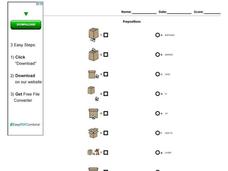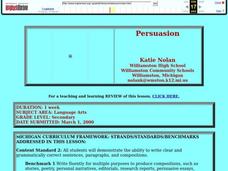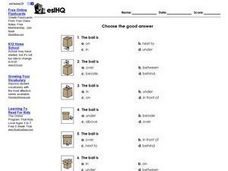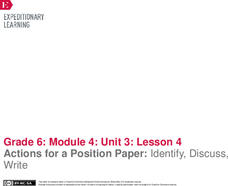Curated OER
Preventing Water Pollution
Fourth graders write at least two ways to clean the water and two ways to prevent pollution with appropriate guesses, striving not to create any more pollution in the water. They understand how pollution affects water as well as the rest...
Curated OER
No Title
Sixth graders, after reviewing and studying the basics of recording, analyzing and presenting data, create on graph paper a bar or line graph to represent given data and then interpret the data. They answer questions about the given data...
Curated OER
Rain and Our Environment
First graders understand the importance of rain in our environment by writing a sentence about something in existence that would cease to be without rain. They use describing words to describe the living thing's color and draw and color...
Curated OER
Beginning With Writing
Students brainstorm what it means to "convey ideas in writing" They review the standard graphic clarify vocabulary and Discuss the importance of having a standard definition for writing and making sure everyone is in agreement of that...
Curated OER
Looking at the Community Tree
Third graders review the characteristics of living and nonliving organisms. As a class, they observe a tree and describe the interactions between the living and nonliving organisms surrounding it. To end the activity, they ask a...
Curated OER
Language Arts: Writing Diamante Poems
Third graders discover how to write diamante poems and review the parts of speech contained in them. After writing poems about their teacher, they create ones about themselves. The poems, assessed for creativity and handwriting, are then...
Curated OER
Points in a Complex Plane -- Lecture
Students review plotting points on a coordinate plane. Individually, they add and subtrace complex numbers and graph them in a complex plane. They follow along a worksheet while their teacher lectures on the new material and solve...
Curated OER
Prepositions
In this ESL word and picture matching learning exercise, students analyze 7 pictures that depict the position of a ball in relation to a cardboard box. Students match these with the words that describe them.
Curated OER
Introduce /A/
Students say the sound for the letter a, reviewing the position of the mouth and voice box. In this phonics lesson, students brainstorm other words that begin with the /a/ sound and choose the letter from a set of 12, continuing...
Curated OER
Lessons from History
Students review key vocabulary in history and review a specific website. They write a paragraph summarizing an event they read about on this website. They analyze the importance of studying and learning from history.
Curated OER
Combination of Atoms
In this atoms learning exercise, students review protons, neutrons, electrons, molecules, compounds, and ions. This learning exercise has 10 fill in the blank and 3 problems to solve.
Curated OER
Jan Ken Pon
Fifth graders explore components of Japanese language, song, instruments, and music. Dotted eighth and sixteenth notes are practiced, the pronunciation of words for the song taught, and chords for tone chimes played in this lesson.
Curated OER
How Much Radiation is Around You?
Learners examine the use, misuse and fear of radiation. They read an article about radiation on food and discuss the positives and negatives of this process. They answer questions to complete the activity.
Curated OER
Once In a Blue Moon
Pupils review the characteristics of the planets and their moons. Using the internet, they research the relationship between the Earth and its moons. They take a template of the moon and draw craters of different colors to present to the...
Curated OER
Persuasion
Students explore the characteristics of a persuasive letter. They label each characteristic and they create a persuasive letter using the correct business letter format. Students recommend a school rule or change of a rule and justify...
Curated OER
Through the Odyssey, Lesson 2:
Ninth graders complete their reading of "The Odyssey". Using the text, they write an essay on a topic of their choice relating to the book. They write a rough draft, first draft and final draft typed in a word processing program. They...
Curated OER
Where Is The ...?
In this prepositions worksheet, students examine 7 pictures that show the position of a ball in relation to a cardboard box. Students answer the question, "Where is the ball?" by writing their answer in a sentence on the line.
Curated OER
Simple Past Survey
In this simple past ESL activity, students will focus on answering questions using the simple past tense. Students will respond to 8 simple past questions by responding in the positive or the negative.
Curated OER
Choose the Good Answer- Prepositions of Location
In this ESL vocabulary building worksheet, students study 7 pictures that show the position of a ball in relation to a cardboard box. Students answer 7 multiple choice questions about the pictures in which they choose the correct...
Curated OER
ESL Use of Prepositions- Where is the Ball? Multiple Choice Worksheet
In this ESL preposition activity, students examine 4 pictures of a ball as is position in relation to a box. They choose the best answer, out of four choices, to the question, "Where is the ball?"
Curated OER
Preposition Matching Game
In this ESL prepositions vocabulary worksheet, students analyze 7 pictures that show the position of a ball in relation to a cardboard box. Students match these pictures to the prepositions that describe them.
Curated OER
"Rikki-Tikki-Tavi"
Students explore nature by reading stories in class. In this animal characteristics lesson, students read the story "Rikki-Tikki-Tavi," by Rudyard Kipling and identify the different animals mentioned in the book. Students review the...
EngageNY
Actions for a Position Paper: Identify, Discuss, Write
Anchors aweigh, it's time to write! After viewing an anchor chart detailing the parts of a position paper, pupils share their plans for their essays with a partner. Next, they write the rough draft of their body paragraphs.
Curated OER
Intro to 1D Kinematics with Physlets
Twelfth graders examine illustrations and animations on a Physlets CD in which they must describe motion, analyze graphs, and calculate initial velocity. The Physlet assists in providing active class participation in discussion.























